History・Legendary(Archaeological materials/Prefectural cultural properties)
Archaelogical Sites in Setouchi
At present there are 52 sites in Setouchi where important historical relics have been unearthed. A brief introduction to these follows.
The Katoku archaeological site
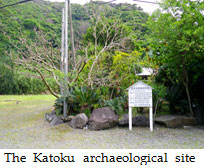 Located on a sandhill near the mouth of the Katoku river, the Katoku archaeological site was discovered accidentally in 1973 during the removal of sand for construction purposes. The first scientifically conducted excavation in Setouchi was carried out at the Katoku site. The age of the materials uncovered ranges from an estimated 1,400 to 6,000 years ago, with most relics coming from the late Jōmon period.
In dozens of locations within the site carefully laid stones, patches of scorched earth and animal bones have been uncovered, suggesting that the Jōmon age Katoku people cooked their food. However, most of the earthenware found has been of a size too small for cooking, implying that foods were roasted over fires or perhaps steamed.
Pottery of a previously unknown style was also unearthed at this site, and this type of earthenware is now known as "Katoku style pottery". The finding of Katoku style pottery within an archaeological site anywhere in the Ryukyus is now used as an indication that that layer belongs to the late Jōmon period (about 4000 years before present).
In addition to pottery from other islands within the Ryukyu chain, pottery from the south of Kyushu has also been unearthed at Kotoku. This demonstrates that oceanic trade was well developed at this time.
Earthenware from the Katoku archaeological site.
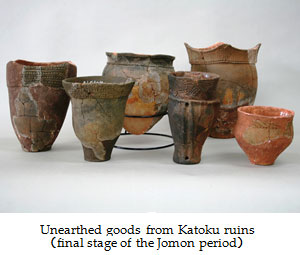 This Amami earthenware was excavated from the Katoku archaeological site,
and is believed to be about four thousand years old (late Jōmon period).
Six Katoku earthenware relics are on display at the Setouchi Municipal
Museum.
The Ankyaba archaeological site
This site is located on the sandhills of Ankyaba village, at the north-east
end of Kakeromajima. Excavations here have exposed earthenware estimated
to have been made around six thousand years ago, during the early Jōmon
period of Japanese prehistory. These items display a "Jōkonmon"
pattern. Other relics that have been unearthed include Yayoi period earthenware
from southern Kyushu, chert arrowheads, and pottery in the Kaneku and Katoku
styles.
The Sukomo village archaeological site
Located in the south-west of Kakeroma, the excavation of this site occurred in parallel with road works that were being carried within the Sukomo village itself. Aside from shedding light on some aspects of the noro (priestess) cult traditions, relics stretching back to the middle Yayoi period have been uncovered. Of particular interest are the many gohōra conch shells (Sinustrombus latissimus) that have been found. The shell of this conch was prized for making bracelets by the people living in northern Kyushu during the Yayoi through to the Kofun periods of prehistory. It is believed that a trade in conch shells existed between Kyushu (where the shell is not found) and the Ryukyus (where the conch is relatively abundant).
Another interesting feature of this site is the number of relics that were not made locally―Yayoi period earthenware from south Kyushu, celadon and white porcelain from China, satsuma-yaki porcelain from Kagoshima, and tsuboya-yaki porcelain from Okinawa. The Sukomo village site clearly shows that trade have been important to the Amami region since prehistoric times.
Kamuiyaki
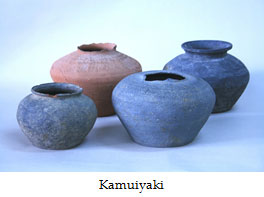 Kamuiyaki is an unglazed pottery which was made from the late 11th century up until the 14th century in Tokunoshima. This pottery was traded throughout a region stretching from the south of Kyushu right down to the Sakishima islands not far from Taiwan. The site of the Kamuiyaki pottery kilns was officially recognized as a nationally important historic site in 2007.Kamuiyaki are small pots, but they are rarely unearthed in an unbroken state. Complete jars have mostly been found in Kikaijima and Amami Ōshima, and ten have been discovered in Setouchi (of these, four are on display at the Setouchi Municipal Museum).
The unbroken Kamuiyaki appear not to have been in everyday use, as almost all examples were recovered from burial sites, along with porcelain, other pottery, and human remains (burnt bones).
Setouchi town folk events
All the following dates refer to the old twelve-month Japanese calendar, often called the lunar or zodiacal calendar. Adding a month to the old date will give you its approximate modern equivalent.
The familiar twelve animals of the Chinese zodiac were not just used to designate particular years in a twelve-year cycle, but also for many other things including the months of the year, days in a twelve-day cycle, and hours within a day. The particular day on which a festival is held is often determined by its zodiac animal designation, for example a festival might be held on the first Horse day in April.
New Year
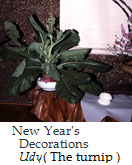 Traditional New year’s cooking is based around pork. It is boiled together
with the wild herb tsuwabuki (Farfugium japonicum, called Tynbasha in the
local dialect). Decorations include a flowering turnip, which is put on
the tokonoma (ornamental alcove in the main room of a house).
March 3 in the old Japanese calendar
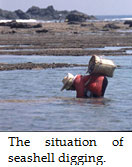 On March 3 (of the old Japanese calendar) the lowest tide of the year occurs. Many people take time off work and go clamming with family, relatives and friends. It is not the shellfish gathering that is important, but the time spent on the beach together. People used to say that someone who doesn't go to the beach on this day will become a crow or an owl.
May 5 in the old Japanese calendar
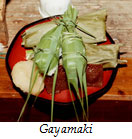 On this day, called "the boy’s festival", people placed sweet flag (Acorus calamus) at the front of the house as a charm to ward off demons. Gayamaki are also made and placed before the family altar or on the tokonoma (the decorative alcove found in the main room of a house). A gayamaki is a ball of rice wrapped in cogon grass (Imperata cylindrica) and sweet flag leaves. There are some villages that hold boat rowing competitions. Kiji villagers on Kakeroma have the tradition of repairing their stone fishing wall on this day.
The Boat Paddling Races
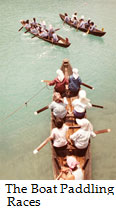 A boat paddling race is held every year during Setouchi's "Harbour
Festival". Traditional Amami boats called itatsuke, each holding seven
or eight people, race against other. All kinds of teams compete―village
teams, office teams, neighbourhood teams, class reunion teams and so on.
In earlier times every village had its own paddling race, and often its
own race day, but nowadays you rarely see a boat race outside of the "Harbour
Festival".
Tanabata
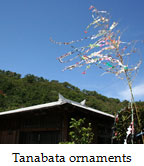 On July 7 of the old Japanese calendar, bamboo poles decorated for the
Tanabata festival can be seen standing in people's gardens throughout Setouchi.
It is said the the Tanabata poles act as landmarks for the ancestral spirits
who return to their families during the Bon period.
Bon Festival
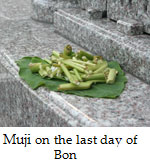 The Bon Festival lasts for 3 days, and starts on July 13 on the old Japanese
calendar. On the evening of the last day, cut muji (potato) stems are offered
as a souvenir to the ancestral spirits returning to the other world.
Arasechi
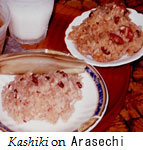 Arasechi can be thought of as the "New Year's Day" of summer,
and occurs in August of the old Japanese calendar. Villagers make kashiki
(festive red rice) to mark this turning point.
Shibasashi
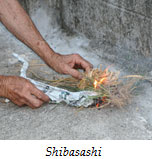 Shibasashi is a ceremony carried out 7 days after Arasetsu. In the evening
of the day before, a type of grass (shiba) is thrust under the eaves of
the house. On the day of the Shibasashi ceremony it is believed that the
spirits of the people who died at sea return to their homes. To dry their
wet hands and feet, rice chaff, straw and grass are burnt at the gate of
the house.
The Harvest Festival
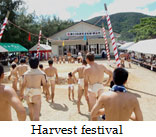 This is an important event for the village. It is held before Arasetsu
and Shibasashi, the first Saturday before August 15 on the old Japanese
calendar. In the afternoon, Sumo and a variety of other performances are
enjoyed in the Mya (the central space of the village) and in the community
hall. It is the custom for the people attending to make a donation, and
this money forms a major part of the operating funds for the village.
The Ninth of September
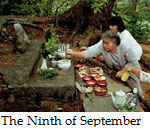 On the Ninth of September (according to the old Japanese calendar) people visit their local shrine, make a wish, and ask that the previous year's wish be forgotten. A traditional island drink called miki, made of fermented rice and sweetpotatoes, is offered to the shrine god. On this day also, the Shodon Shibaya festival (an "Important Intangible Cultural Asset", as designated by the national government of Japan), is held.
August Dance
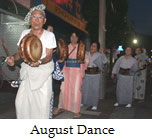 The August dances are a traditional folk entertainment unique to each village.
The dances are performed on many different occasions, such as at Arasetsu,
housewarming parties, and the Harvest festival. Originally danced in everyday
clothes by people of all ages, men would stand on one side of a circle
and women on the other, and each side would sing out to the other during
the dance. Nowadays, each village dances a different dance and sings a
different song, but often all dancers will wear matching yukata (summer
kimono). The rhythm of the dance is kept with small drums covered with
horse or goat. An August dance competition is held every year in Koniya.
|


















